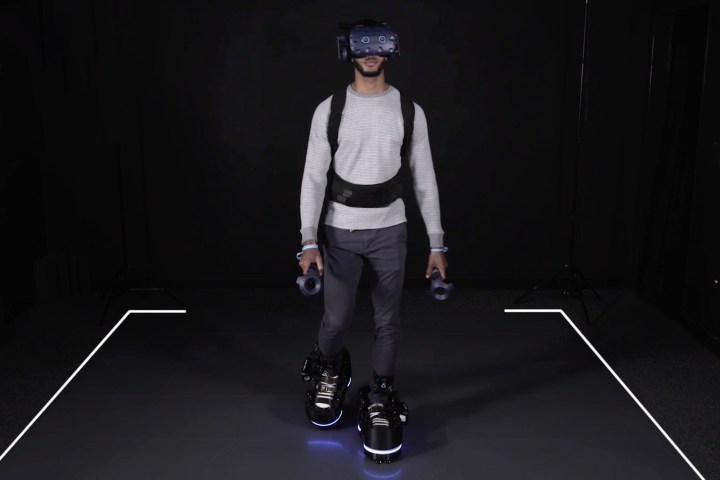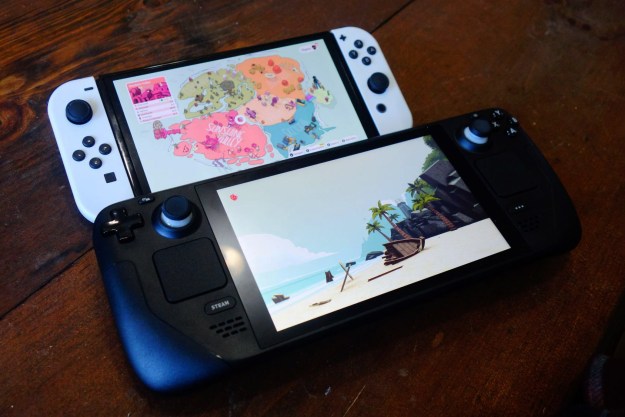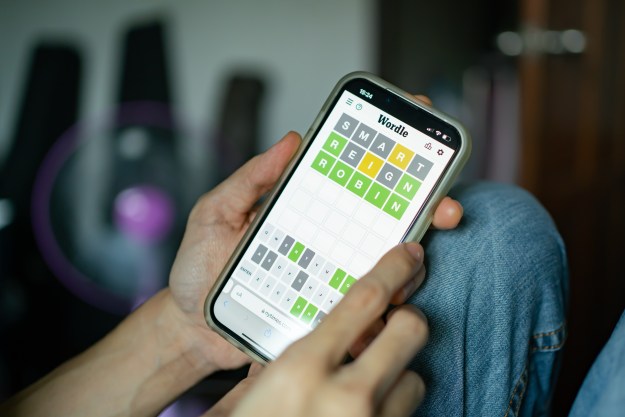“It’s about the continuity of the experience,” said Brad Factor. “It’s about maintaining that immersion. It’s about ease of use and the learning curve: not needing to teach somebody how to use VR, but just being able to put on the headset and experience the virtual world naturally. That’s a lot of what we’re focusing on.”
Factor, the founder and CEO of a company called Ekto VR, has invented what is, in essence, a pair of chunky, cyberpunk-looking moonwalking boots for use in virtual reality environments. If Dorothy wore ruby slippers to travel in safety through the magical, technicolor land of Oz in The Wizard of Oz, then Factor’s invention is designed to allow similarly safe travel through VR.
Ever wonder how it’s possible to create a convincing VR scenario that lets you, say, trek through the Sahara Desert without the painful, immersion-breaking experience of colliding with a wall in your apartment? Ekto VR believes it has the answer: Slip on a pair of the company’s simulator boots over your regular shoes, don a VR headset, and you’re able to experience walking through virtual environments that are far, far larger than the physical space you’re contained within.

Ekto VR’s boots work by using an array of motorized wheels on their underside, which spin counter to the speed that the user is walking in. In order to avoid motion sickness, the boots allow the wearer to initially take several steps forward. This is done to provide the necessary vestibular inner-ear cues to tell their bodies that they are accelerating forward. However, after a few steps, the boots automatically glide the wearer back to the center of the room so that they appear to be walking on the spot, as if on a treadmill. Meanwhile, the user believes they are continuing to make forward progress — and, based on the VR scene they’re experiencing, they are.
“As far as the comments that we most receive in demos, people are almost utterly convinced – and, in some cases, utterly convinced – that they are going to walk out of the room,” Factor told Digital Trends. “People ask us, ‘Are [the boots] on? Are they working? Am I getting close to the edge [of the room]?’ It’s really as if they don’t have any sense of where they are. They are immersed in the environment to the point that they are uncertain they are still within the room that they started.”

(Note: Digital Trends has not been able to put these shoes through their paces ourselves.)
Before he set out to create VR boots, Factor was employed by Honeywell Aerospace, where he spent eight years building flight control systems for airplanes like the Boeing 787 Dreamliner. In that case, he was responsible for some of the core technologies that allow 200-300 people at a time to sit, apparently stationary, inside a large metal tube, before emerging thousands of miles away at their destination.
Now he’s working on the inverse of that problem: Keeping people stationery while tricking their brains into thinking they’re traveling great distances. If he can crack it on a commercial level, he’ll be the first — but he’s not the only one to try.
The endless walking problem
Ekto VR isn’t the first company to attempt to solve the endless walking problem in VR, sometimes referred to as the LI (locomotion interface) challenge. Efforts to do so date back at least as far as the 1980s. In Howard Rheingold’s 1991 book Virtual Reality: The Revolutionary Technology of Computer-Generated Artificial Worlds, and How It Promises to Transform Society, the author recounts using a VR treadmill at the University of North Carolina.
Paired with a VR headset, the treadmill allowed users to walk through a virtual version of Sitterson Hall, today the home of UNC’s computer science department. In doing so, the VR demo made it possible to experience what it would be like to walk through a three-dimensional, full-sized version of a building that was then still in the construction phase.
“I was able to stroll the corridors of an entire building while physically never leaving one small room because I was pacing along a treadmill, holding on to a pair of handlebars,” Rheinghold wrote. “When I wanted to steer to the right and discovered what was down the hallway I could see stretching out in that direction, I turned the handlebars and kept walking straight. It took a minute to get used to.”

Aside from UNC, other attempts at solving the endless walking problem were carried out at the University of Utah, which developed a machine called the TreadPort. It featured a large treadmill with a tilting mechanism, combining locomotion interfaces with visual, auditory, and olfactory senses – and even radiant heat and wind elements.
Plenty of work has also been done in Japan, particularly at the University of Tsukuba. “I would say you could point to every single solution that’s out there today, particularly hardware ones and say [that researchers at the University of Tsukuba] already tried it,” said Factor. “They did an omnidirectional treadmill. They did something very similar to the starting point we had, called powered shoes. They did a string walker. They tried, like, eight different approaches, maybe even more. I don’t think they tried to push any of them forward [to the point of commercialization].”
More recently, an innovative solution to the endless walking problem was developed by researchers from Unity Technologies Japan, which creates the illusion of an infinite virtual corridor inside a “play space” that measures 16 x 22 feet. Called “redirected walking,” the approach aims to trick the brain into thinking the subject is walking in a straight line when, in reality, they are walking in a giant circle.
Yet another approach, developed by researchers from Stony Brook University, Nvidia, and Adobe, does something conceptually similar by using an eye-tracked HMD (head-mounted display) to detect users’ saccades, the rapid eye movements that occur when individuals are looking at different points in our field of vision — for example, scanning a room. By effectively “hacking” these saccades, it’s possible to redirect users’ walking direction without causing dizziness or discomfort.
“We are the most complicated biological system, certainly more than any treadmill for example, right?” Qi Sun, lead author of the study, told Digital Trends. “So why don’t we don’t use the most common, yet complicated machine – ourselves – to enable that type of experience that we want to solve. That was the original higher level motivation of this research.”
What’s interesting about the myriad approaches to solving the endless walking challenge is that, even several decades on, there is still no one agreed-upon solution that has caused researchers to scrap all others. No one has yet created the perfect commercialized solution that clearly lights the path to the future. That means that not only is there still everything to play for in terms of who owns this market, but also the specifics of the approach taken.
The next big thing in VR?
Will locomotion interface tech be the next big thing for virtual reality? A lot depends on whether VR is ultimately about creating virtual worlds or simply providing a new kind of interface. If it is an interface, used predominantly for practical applications like the VR equivalent of Zoom meetings, this kind of realism may not matter all that much. In that case, being able to walk great distances in VR might be not just unnecessary but actually a detriment to the user experience. For example, a VR version of shopping doesn’t necessarily need to replicate the experience of walking up and down aisles and carrying an increasingly heavy basket. That would be a major downgrade next to the seamless ease of Amazon’s one-click shopping.

On the other hand, if VR’s most compelling use cases come from creating convincing virtual worlds, the locomotion problem absolutely needs to be solved. Study after study has shown that subjects find virtual reality environments more immersive, with a higher subjective sense of presence, when they move around it through virtual walking rather than, for instance, teleporting between locations using a handheld controller. As one 2004 study from researchers in Japan puts it, the sensation of walking affects “people’s cognitive maps,” the way that our brains process distance and movement. In short, walking adds verisimilitude to VR that can trick our brains into perceiving what we’re seeing as real.
Gaming is a great example of a use case that will only get more compelling the closer the experience is to reality — but not just for gaming. For instance, if you’re an architect wanting to show a commercial real estate client what a new shopping mall design will look like when it’s built, being able to pace through a virtual version of the building (as Rheingold discussed more than 30 years ago) would be extremely beneficial.
Industrial applications and beyond
As far as Ekto VR goes, Factor said that his company is initially aiming for these latter kinds of industrial applications.
“When you get into the kind of the larger [VR] training applications, talking about refineries, or pipelines, or offshore platforms, or manufacturing facilities, or airplane inspections, people will say, ‘Well, [we could just use an interface that teleports users around it,]” he said. “That’s great from a throughput perspective if the thing that you’re optimizing for is needing to see areas that are completely independent of each other quickly. But we’re getting more and more into these more comprehensive scenarios where you need to do a full aircraft skin inspection, or to see how something at the tail wheel [of a plane] connects to the nose wheel, or one valve in a plant affects a condenser in another part [of the building]. These really require you to understand your surroundings a lot better [and how they spatially relate to each other.]”
With those types of industrial applications in mind, Ekto plans to launch its partner beta program in the first half of 2022. As far as pricing goes, Factor said the company is still weighing up its options — from offering kits for sale or lease. Exact pricing has yet to be announced, but an initial outright purchase would likely be in the vicinity of $15,000-$20,000.
“Now, obviously, those kinds of prices that we’re talking about, they’re not consumer – and, to some extent, aren’t even really a good fit for most of the enterprise use cases,” Factor said. “A lot of that is the low volume at this point. As we scale volume up, we’re expecting to bring costs and prices down dramatically.”
Eventually, he said, the company will aim to sell to the market for prices below $1,000, making it a more compelling proposition for everyday applications. That includes the prospect of more consumer-facing use cases.
Endless walking isn’t the only absent part of the virtual reality puzzle. Simulating touch, smell, taste, and more are other areas yet to solve – which are only starting to get the attention of forward-looking investigators. Expect to see a whole lot more of this in the months and years to come. After all, the hype surrounding VR — one part of the larger concept of a Metaverse— hasn’t been hotter in years.
Whatever you label it, we’re going to be spending a whole lot of time in virtual worlds, so it’s crucial to get it right.
Editors' Recommendations
- This modular SteamVR controller fixes a major problem with VR controllers
- You can now high-five in VR


